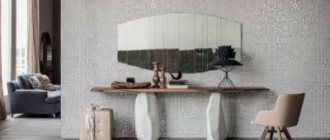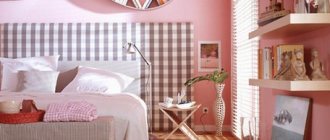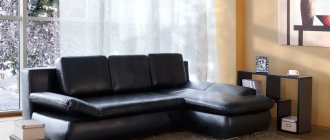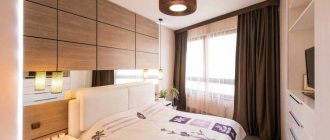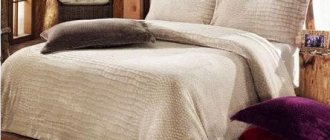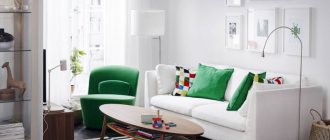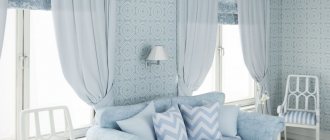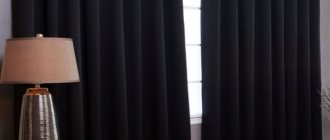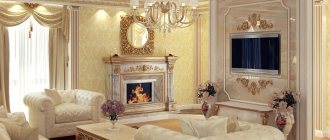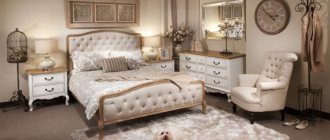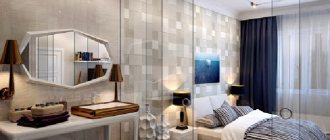What types of fabrics are used in the interior?
Any textile design begins with fabrics, which in turn can be natural or synthetic.
Cotton
Eco-friendly composition, pleasant texture, durability, ease of care, and a huge selection of colors make cotton an ideal textile option for any room. Curtains, pillowcases, bedding are made from natural cotton, walls are decorated, and furniture is upholstered.
The photo shows the colors of natural cotton
Linen
As a rule, textiles made from linen fibers have natural shades - beige, gray, light yellow, yellow-green. Linen is used for sewing bedding, decorative pillowcases, tablecloths, and curtains.
Look at examples of using linen curtains in the interior.
Wool
An interesting texture has every chance of becoming an accent in the interior. Bedspreads, blankets and even pillowcases made from yarn will complement the bedroom or living room. And natural carpets last much longer than artificial textiles.
Gozhka
If your goal is to create a texture in textile design that is close to cotton or linen, but at the same time choose a more practical fabric, give preference to matting. Thanks to durable fibers, the fabric wrinkles less, is easier to clean and lasts longer.
Among the large selection of shades and textures, it’s easy to find one that suits your desired interior style. The matting is suitable for any purpose: from upholstery to sewing pillowcases.
In the photo the texture of the matting
Chenille
Unique fabric: soft and textured at the same time. Chenille is very durable, which is why it is most often used in furniture making. Although it is also suitable for curtains or bedspreads.
Jacquard
Durable but refined fabrics are preferred by fans of classic, palace styles. Both a jacquard sofa and complex curtains look equally good.
Velvet
In textile design, velvet occupies a separate place: its pleasant fleecy texture, combined with deep shades, has been used in interior design since ancient times.
In a modern apartment, velvet furniture, curtains, and pillows add a touch of luxury to the design.
Pictured is emerald velvet
Velours
Unlike velvet, velor has less of a touch of elegance, but a larger range of colors, including simple light, complex deep and bright saturated tones. The scope of application is the same: furniture, decor, curtains.
Flock
One of the few textile options in the interior, the texture of which is achieved not through weaving, but with the help of pile spraying. Thanks to this technology, flock is not afraid of snags and is often used in apartments with animals. Suitable for upholstery, accessories.
Tapestry
A special place in the list of textiles is woven fabric with a beautiful pattern. Tapestry was popular in the late 20th century, but today it is making a comeback in textile design as furniture upholstery or fabric for a variety of items (from pillows to bedspreads).
The photo shows a classic tapestry
Variety of fabrics and ways to use them
Textiles are varied. In each specific style, only certain types of material are used, which can look rich, sophisticated, elegant or modest and restrained. Fabrics can be pleasant to the touch or have a rough texture. Depending on the characteristics of the material, the scope of its application is determined. For example, durable velvet is suitable for sewing curtains, upholstery and canopies. It is not recommended to test thin silk for strength, since it is easy to put “puffs” on the material. All textiles are classified by origin into two large groups:
- Artificial;
- Natural. It, in turn, is divided into two types: animal and plant origin.
There is a third mixed group, which includes fabrics made from synthetic and natural fibers. Typically, this technique is used to reduce the cost of the finished material without seriously compromising quality.
Velor and velvet
Velor and velvet are pile fabrics. Their surface is densely covered with characteristic villi that can be smoothed by hand. Thanks to the special texture of the fabric, its shades acquire a special depth. Velvet and velor are considered the main materials for the classic style. The materials are made using two different pile weaving technologies. Velor is classified into three main types:
- Knitted;
- Fur;
- Leather.
In addition, there is another classification based on appearance:
- Embossed;
- Printed;
- Shaped;
- Smooth;
- Smoothly colored.
For the manufacture of upholstery, special furniture velor or jacquard fabric, which is its variety, is used. For car interiors, they use fabric made from synthetic fibers, which is characterized by increased strength and abrasion resistance. Velvet is used to make pillowcases, bedspreads, curtains, and furniture upholstery.
Both materials are considered hypoallergenic, but due to their texture they collect dust, which can still cause a negative reaction in humans. Velvet and velor are durable, they do not shrink, but fade in the sun. It is difficult for craftswomen to work with fabrics by hand. Both velor and velvet take a long time to dry after washing, which, by the way, can only be done in a delicate mode and using gentle products. Ironing the material is strictly prohibited. To bring it back to its previous form, you will have to “ruffle” the villi for a long time. This type of textile is considered a sign of wealth. Velvet symbolizes luxury and wealth. Just like expensive jewelry, there shouldn’t be too much of it. Otherwise, the interior faces the stigma of bad taste.
Many needlewomen use the so-called chenille. This reinforced thread is decorated with fluffy fibers along its entire length. In essence, this is velor, but intended for decoration.
Calico and ranfors
According to Russian standards, calico is a fabric made from 100% silk. In other countries, it is allowed to add up to 20% artificial fibers to the fabric. When purchasing, you should pay attention to the country of origin. It has a pronounced texture: the interweaving of fibers is visible to the naked eye. Calico is environmentally friendly and hypoallergenic. It appeared in our country back in the 16th century. Merchants from Arab states brought relatively new material. Calico is classified into four types:
- Harsh. Despite the “formidable” name, the severity of matter is manifested only in its increased strength. This calico is not dyed or bleached. It has a natural creamy shade. It is used for the manufacture of workwear and furniture upholstery.
- Smoothly colored. Plain calico, which is used for sewing towels, tablecloths, napkins and bed linen.
- Bleached. The fabric that is bleached is used only for sewing bedding sets.
- Printed. The fabric is decorated with bright, multi-colored designs. Used for sewing clothes and bed linen.
Ranfors is a super-strong material that is made using complex technology from yarn and Egyptian silk. The threads are additionally polished, combed and twisted. The result is a material that is several times denser than calico. Ranfors is characterized by hypoallergenicity, ease of care, reasonable cost, strength, durability and ability to absorb moisture. The material is used mainly for sewing bed linen and clothing. Occasionally, curtains are made from ranfors, which, by the way, “breathe” like other natural textiles.
Cotton
Cotton is based on short, slightly twisted fibers around its axis. The material perfectly resists fading and brilliantly withstands contact with aggressive household chemicals. Cotton can last a long time, but only with regular care. The most noticeable drawback of the material is the lack of ability to hold its shape for a long time, that is, the fabric wrinkles easily and can shrink. Depending on the production technology, ordinary light cotton and its more rigid variation are obtained. The first type is used for sewing clothes, tablecloths, napkins, bed linen and curtains. By the way, over time, the material on the windows will turn slightly yellow. Rigid cotton is used to make collars on men's shirts and upholstery.
Cotton in the interior is used not only in the form of finished fabric, but also as a “living” decor. The branches of the plant with characteristic lamb-like caps will last a very long time when dry and will delight the eye all year round.
Atlas
From Arabic “atlas” is translated as “smooth”. The fabric really has a pleasant texture and a slight glossy shine. The satin is very pleasant to the touch, and its appearance is associated with refined and elegant interiors. Common people often confuse satin and satin. The fabrics are indeed produced using similar technologies, but their characteristics are different. China is considered the birthplace of the atlas. The technology for producing matter was kept secret for a long time. The monopoly on the atlas allowed it to be sold to other countries (including Russia) at high prices. Depending on the type of coloring, matter is classified into four types:
- Plain.
- Trianon. Satin with contrasting pattern.
- Maintenon. A pattern is applied to a plain fabric background that looks more like a faint print.
- Pompadour. Dark satin is decorated with a gold pattern.
Satin is made from silk threads, but recently synthetic fibers, viscose and cotton have been added to them in order to reduce the cost of the material. The fabric is durable, does not shrink, retains colors for a long time, absorbs moisture, and does not wrinkle. If the edges of the satin are left untreated, they will quickly begin to disintegrate into individual fibers. Do not wash fabric in hot water. If the material contains synthetic fibers, then such satin can stretch with prolonged use. The fabric is quite heavy. Satin is used for sewing clothes, curtains, bed linen, tablecloths, and upholstery.
Silk
Silk is an expensive natural fabric that has a pleasant glossy shine and is soft to the touch. Silk is sometimes compared to the surface of water. China, as in the case of atlas, for a long time maintained a monopoly on its production. The material was supplied along the Great Silk Road. By the way, the Trans-Siberian Railway subsequently largely repeated the caravan route that connected Europe and Asia. Although the once secret technology has long been made public, China remains the leader among silk suppliers. The thread for the fabric is obtained from the tiny cocoons of silkworms. Silk is classified into many subspecies:
- Crepe. The fabric has a grainy texture and is rough to the touch. This effect is achieved by repeatedly twisting the threads when making crepe.
- Organza. A fabric that, despite its lightness, holds its shape perfectly.
- Atlas.
- Taffeta. Rigid fabric with good dimensional stability. Used for sewing petticoats.
- Chiffon. A very expensive fabric that belongs to the silk elite. It is mainly used to make clothing. Chiffon feels slightly grainy and rough to the touch. It may have a rare pearlescent color with characteristic iridescent shades.
- Toile. Fabric decorated with a pattern over a plain background. Previously, toilets were used to cover the walls of houses. A kind of first fabric wallpaper.
- Satin. Simplified version of the atlas.
- Chesucha. It is also called wild silk. The fabric is woven from the remnants of threads that vary in thickness. It has a rough appearance, but is very beneficial for human skin. It is most often used for sewing clothes, and in rare cases - for bed linen.
- Gas. A very light, airy fabric that is used for sewing tulle.
- Foulard. The finest type of silk, which is used for sewing veils and scarves.
Silk does not cause allergies, “breathes”, does not deform, but at the same time stretches easily. However, the cost of the fabric leaves much to be desired. Silk should not be exposed to regular sunlight. It can only be washed on a delicate cycle and will have to be ironed with extreme caution. Silk bed linen will give you a feeling of coolness in the hot summer, but at the same time it “slips” a lot, which many will consider as a disadvantage. The material is used to make upholstery for furniture, kitchen decor, curtains and curtains.
Linen and burlap
Linen has strength, wear resistance, and the ability to remove moisture and heat. This material is used to make clothes that are popular in the summer heat. Linen has a somewhat rough texture and is rough to the touch. The material wrinkles easily, does not hold its shape well, and sometimes shrinks after washing. Unlike cotton, linen does not turn yellow over time, but retains its original whiteness. The fabric does not pill and is used for sewing tablecloths, towels, hypoallergenic bed linen, curtains and for making furniture upholstery. Linen goes well with Provence and rustic styles, which are embodied in dachas and country houses. Burlap has a similar texture. This material is made from flax and jute in a 1:1 ratio. Burlap is strong, durable, does not stretch and is not afraid of contact with sunlight, water, and household chemicals. But due to the unsightly appearance of the fabric, it is rarely used in the interior. Rough burlap harmonizes with country, minimalism and eco style, that is, with trends that gravitate towards simplicity and naturalness. Fabric is used primarily to make upholstery for furniture.
Burlap and linen are often used to make bindings for books and notepads. The texture of the materials allows you to create original covers.
Felt
Felt is made from sheep wool by felting. For many years, material was obtained only through long and monotonous manual labor. Felt is very warm, it is not afraid of fungus and mold, and does not electrify. However, the material quickly absorbs moisture, weighs quite a lot, becomes a favorite “food” for moths and is prone to shrinkage after washing. Felt is used to insulate houses; it is used to make toys (including interior ones), bath accessories, felt boots, bags and mittens. Warm blankets and pillows made from this material will provide great warmth in the harsh winter.
Boucle
Bouclé is made from crepe or fancy yarn. The material has a rough texture: loose weaving, which is often decorated with protruding knots. Externally voluminous, it is light in weight. Most of all, bouclé resembles astrakhan. The material is obtained from wool, silk, cotton and viscose. Bouclized polyester is used to produce furniture upholstery. Bouclé retains heat well, does not wrinkle, does not stretch, and does not shrink. However, the edges of the material, if they are not processed with an overlocker, quickly crumble. Nodules on the surface contribute to the formation of puffs. Boucle is used for sewing upholstery and furniture covers. Warm blankets made of this material provide warmth and create additional comfort in the room.
Artificial/chemical fabrics
Chemical fabrics are made from synthetic and man-made fibers. This is a new word in the textile industry. Man-made fibers are made from organic matter. Seaweed, cellulose, and cotton are treated with acetone, acetic or nitric acid. Synthetic fibers are made from polymers that do not occur naturally. Chemical fabrics include acetate, polyester, lavsan, viscose, nylon and nylon. The development of new technologies for the production of synthetic fibers is ahead of projects to improve the production of artificial threads. Many say that synthetics are the future. However, no chemical fabric has yet managed to surpass the characteristics of natural fabric. To increase their wear resistance, strength and ability to retain shape, natural fibers are often added to the compositions in varying percentages. Chemical fabrics are used for sewing clothes, bed linen, curtains (including thread “icicles”), pillows, bedspreads and furniture upholstery. The popularity of these materials is largely due to their availability and low cost.
How is it used in decoration?
Surprisingly, textiles are not only carpets and sofa cushions. In some cases, fabric wallpaper and ceilings are used.
Wallpaper
Do you want to add some zest to your interior? Pay attention to textile wallpaper: fabric walls, of course, will not fit into any interior, but in the right environment they look very harmonious.
Due to the high price, such wallpapers are mainly chosen by wealthy people. In addition to cost, fabric wallpaper has other disadvantages - they require great care when gluing, require special care, and tend to accumulate dust (like any textile).
Stretch textile ceilings
Outdated interior design techniques
Monochrome interiors
Often cause heated debate. Some consider this interior to be strict, elegant and stylish, while others consider it boring, pale and reminiscent of a hospital ward. In 2021, there is a tendency to “revitalize” the interior with bright or warm colors . The Scandinavian style is also losing relevance. Monochrome lovers are recommended to add another color to it - a warm shade of textiles, or natural decorative elements - stone or flowers. They will give the design a cheerfulness that is relevant this year.
Ethnic patterns
In 2008-2009, decorating spaces in ethnic style was popular. African and Japanese motifs were especially popular. In 2021, it can be argued that this trend is outdated.
You should also avoid floral patterns, especially in a tropical style, and flowers that are simply too large or small.
Moroccan poufs
They can also be considered an outdated trend, since they belong to the ethnic design style. In addition, according to some designers, they do not decorate or relax the interior, but make it too careless and simplified. Although the “cozy home” trend is more relevant than ever this year, so are things that give coziness and relaxation.
Article on the topic: New Year in ECO style: budget design and home decor
Macrame
Wicker panels and lampshades, which previously fit perfectly into the boho style, are now an outdated design option.
Boho is a combination of many elements, and it is still in fashion, as it combines the most original, relaxed and effective of different styles, allowing the individuality of the homeowners to show. But in 2021 it is better not to use elements in the macrame style.
Carpets and rugs for the entire room
Today, carpets are relevant, but they are used primarily as a decorative element - they should not occupy the entire room. The best option is a small carpet in front of the sofa in the living room, beautiful colors and pleasant texture. The shape is not necessarily the classic square, oval and various original shapes are in fashion.
Beige interior color scheme
Beige shades in the interior have also been in fashion for many years. In 2019, such an interior should be refreshed with bright shades.
In 2021, mustard-gold, mustard-yellow, ultraviolet and other shades of purple are in fashion . Mustard gold will perfectly decorate the white, gray and blue shades of the interior. It is fashionable to make pillowcases for sofa cushions in the same shade as the curtains, or from the same fabric.
It is not necessary to radically change the furniture. It is enough to change the upholstery or sew covers from good fabric that meets modern design.
The trend of the year is eco-style, closeness to nature. Natural materials and fabrics are in fashion, everything is environmentally friendly and safe for the health of household members.
In any case, the main thing is that you like the design of the house so that you feel comfortable. Therefore, if you like everything about the textile design, there is no need to change it. Perhaps after some time, fashion will change and your interior will become relevant again.
ANTI-TRENDS 2021. CURTAINS and home textiles (1 video)
Article on the topic: Features of the interior of the house of Grigory Leps
Textile interior design: what has changed over the last 10 years (14 photos)
Stylistic features
Textiles change from era to era, from direction to direction. Let's look at the most striking examples.
Small blue, pink, yellow flowers are mainly used in rustic styles (for example, Provence) or vintage. Textiles with large floral prints are characteristic of the classical, empire, and baroque styles.
Geometry, in particular the cage, is a favorite technique in rustic style. Dark checkered textiles (tartan, glenchek, argyle) are used in classic English interiors.
Retro style also gravitates towards geometry in textiles, but in addition to checks and stripes, you can find abstract designs here.
The photo shows a retro-style living room
The modern trend, in turn, uses a little bit of everything in textiles, skillfully combining stripes with floristry, and checks with monochromatic companions.
The photo shows a modern living room with a checkered carpet
Secrets of the comfort of the bedroom
Textiles in the bedroom interior
Decorating the interior of the bedroom is done especially carefully. In a home, comfort and coziness are very important for the sleeping area, therefore, the utmost attention is paid to the color palette and texture of the textile components of the bedroom interior.
For proper rest and healthy sleep, the first priority is the correct choice of mattress, pillows and blankets. No less important is the process of sleep itself and the awakening that follows it. This process should occur with a certain degree of comfort.
Textiles play a dominant role in the bedroom. The texture, color and design of bed linen should evoke emotional positivity, both when going to bed and when you wake up.
The choice of textiles - bed linen and a bedspread that matches it in style - is no less important than purchasing a comfortable bed as the central detail of the bedroom interior. In accordance with the color palette of bedding, upholstery material for upholstered furniture and curtains are selected.
How to choose large textile elements (curtains and carpets)
Of course, the larger the element, the more significant role it plays in creating the impression of the interior. If you want it to live up to the name “elite”, you should learn to limit yourself in the pursuit of variety.
For example, to decorate a window, a monochrome palette (shades of the same color) or its combination with neutral tones is desirable. Your curtains can be very complex or quite simple in shape, but color restrictions on combinations are a mandatory rule. For all windows in one room, it is advisable to use a combination of 2-3 fabrics. But the shapes of the curtains may differ slightly.
In addition, a large and contrasting pattern on the curtains is undesirable - it distracts attention from other, more important objects in the room. But if you use plain fabrics, then contrast is quite appropriate.
There are many guides with detailed rules on choosing carpets. For an elite interior, the proportionality of the size of the carpet and the area of the room is especially important. In addition, it is very desirable that individual colors in the carpet pattern be repeated in other interior elements. This creates harmony and prevents the rug from looking like a random object thrown around.
If your choice is classic European or oriental carpets, pay attention to the pattern. If it is large enough, contrasting, variegated or geometric, the upholstery of upholstered furniture is preferably monophonic and neutral tones. And the shades of the carpet can be “supported” by, for example, decorative pillows, a picture above the sofa or vases on the coffee table.
If you want to add a “fresh note” to a strict classic interior, pay attention to “sculptural carpets”: these are products with differences in pile level (high, medium and low). Unlike traditional carpets, their color scheme contains a transition of shades of the same palette or a soft contrast, and some factories create luxurious sculptural carpets of the same tone, but with an original “pile cut”.
Rules of good taste when choosing fabric elements
Unlike furniture, wall and floor coverings, textile decor does not like compromises with style. Those. if your choice is classic, then all fabric elements should be classic; modern details here will disrupt the overall harmony.
This rule certainly applies to luxury interiors. But there are several more points that determine the work of an experienced decorator.
Fabric almost does not exist without a pattern. The only exception is plain fabrics. But in this case, texture plays a special role. More on this later.
First, let’s talk about the design of fabrics that are preferable to use in an elite interior. Absolutely identical fabrics on all pieces of furniture look banal. That is why decorators try to create various combinations of fabrics that are similar in color. Drawings help them with this.
They should be quite restrained and traditionally “time-tested”:
- stripe (for almost any style, wide or narrow),
- check (for styling in European country),
- small floral and plant patterns (for salon and office styles),
- large flowers, monograms and leaves (for Art Nouveau, Glamor and Baroque).
It is advisable not to mix the last category of pattern with anything other than plain fabrics, and the previous three can be combined in any combination.
If you prefer plain fabrics, then the most common option is to play with shades or contrasts.
But there are other, more effective modern techniques, for example, choosing very close or neutral shades and combining different textures (matte and shiny, dense and translucent, voluminous and openwork, smooth and rough to the touch).
Material selection
Decorating with fabric allows you to create bright compositions and individuality. Having decided on the need to use them, it is necessary to find out their quality, which mainly depends on the material of manufacture. First of all, let's discuss this point.
Natural fabrics
Textile decoration with natural fabrics has significant advantages - they are environmentally friendly, washable and antistatic. They are also antistatic. The downsides are that they wrinkle often and easily, take a long time to dry after washing, can fade and shrink, and fade in the sun. Plain materials perfectly reveal flaws in the cut. Linen, cotton, wool, and silk are used in production. There are exotic materials, such as seaweed.
Natural textiles in the interior will be indispensable in ethnic and eco styles. Vintage elements without them will also not look significant. Although natural materials will fit perfectly with any style.
Synthetic materials
Synthetic interior fabrics have an undeniable advantage - they are hypoallergenic. They hold their shape perfectly, are more durable and wear-resistant. Significantly cheaper than the previous option. They have a flat, smooth surface. The downside is that the material is not breathable and generates static electricity.
Produced from petroleum products, cellulose, gas, coal. Due to this, synthetic textile interior design is more common. Production is large-scale and the base is more accessible. For the most part, synthetics are used for upholstery of upholstered furniture.
Mixed fabrics
Textile design with mixed fabrics has its advantages. They have absorbed the best from natural and synthetic materials. They rightfully deserve their popularity. For example, polypropylene materials are lightweight and waterproof, lycra materials are elastic, and acrylic materials are cheaper. Mixing the bases gives the best looks. However, there are some drawbacks. They do not hold dyes well, which is why they soon lose their saturation or fade when used.
Perfectly integrated into classic designs or country style. Although mixed interior fabrics will be in demand in almost any design.
Secrets to updating your kitchen decor
Textiles in the kitchen interior
You can quickly change not only the interior, but also the style of the kitchen without the use of physical force by replacing curtains and kitchen textiles - tablecloths, towels, napkins.
Modern kitchen textiles are created using special technologies and are distinguished by high quality products. Tightly twisted combined fabrics made from natural and artificial fibers are able to repel dirt and moisture, as well as reject fat. Special fabric impregnations allow you to place hot cookware on the textile surface.
Despite the opinion of skeptics that fabric attributes in the kitchen are meaningless and impractical, kitchen textiles are considered an invariable part of the decor.
Kitchen interior decor is akin to a wardrobe. Like clothing, textiles can be replaced depending on the change of season or according to the mood, replacing tablecloths with runners, serving or staging napkins. In any case, visible changes occur in the decorative decoration.
Replacing textiles is a simple and winning option. By experimenting with a variety of shades and textures, you can give your kitchen space a very presentable look.
